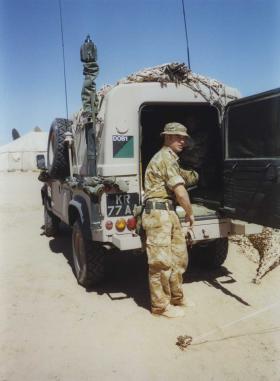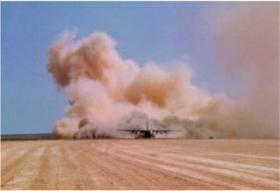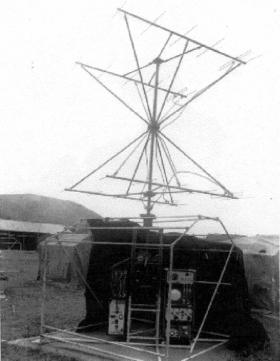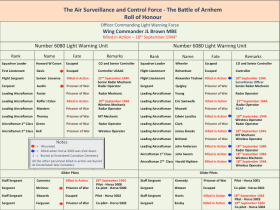The RAF have provided support to airborne operations for over 70 years.
This has ranged from flying dakotas over Normandy and towing gliders over Arnhem to providing ground support in Afghanistan with the Tactical Communications Wing.
An interesting example of this was the use of the Light Warning Units (LWUs) at Arnhem during Op Market Garden.
Operation Market Garden was Field Marshal Montgomery’s bold plan to capture the vital bridges at Arnhem in 1944. The plan required the deployment of two highly secret radar units so that Close Air Support could be given to the lightly equipped airborne units. Having been successful when deployed at Marble Arch in the Western Desert in 1942, and Op Overlord on the 6th June. The LWUs, selected for Op Market Garden were the type 6 radar and Eureka/Rebecca systems. This highly mobile equipment could be housed in a tent or a van sized vehicle.
The LWU had a maximum range of 50 miles and was equipped with a range height display and a Plan Position Indicator (PPI) display that meant that it could be used to control fighter aircraft. It had been produced for two main purposes; first, to provide radar cover rapidly in situations where it was not possible to deploy the larger mobile long-range systems and, secondly, to provide low-level forward coverage for larger mobile radar units RAF engineers and radar controllers attached to the 4th Parachute Battalion landed in Arnhem on 18 September.
They were to control Close Air Support missions by Allied aircraft; if all had gone to plan, this was a task that could have changed the course of history. The 25 RAF personnel were part of two Light Warning Units, each equipped with the top secret Air Ministry Experimental Station and Eureka systems which could be transported in two gliders. The plan was to deploy these systems on the second phase of gliders reaching Holland on 17 and 18 September.
The first was to land at Groesbeek to support the Brigade, As the aircraft began their approach to the landing zones, one glider had to crash land when its tug aircraft was hit by flak and crashed. It landed near the town of Zetten, where the surviving crew destroyed the equipment and, despite having little infantry training, made their way to fight at Arnhem. A second glider was hit by the same concentration of flack and crashed, killing 6 members of the Light Warning Unit, plus the pilots.
The remaining two gliders landed as planned at the landing zone 7 miles west of Arnhem, but the crews soon realised that without all of the equipment, the Air Ministry Experimental Station would not function. As they tried to improvise a solution, both gliders and equipment were destroyed by heavy German fire on the landing zone.
The Light Warning Unit crews then accompanied the infantry-trained glider pilots into battle.
At the end of the week long battle, the remains of the now exhausted 1st Airborne Division were under siege in the Oosterbeek area and, with no signs of respite and little or no ammunition, decided to attempt a risky night time crossing of the Rhine in order to reach the British lines. Only four members of the Light Warning Units, including a US Army 1st Lieutenant, made this crossing successfully and escaped.
Of the 25 Light Warning Unit personnel that were flown into Holland, 10 were killed and the remaining 11 captured. Following Market Garden, similar LWU under 38 group came under the operational control of the 6th Airborne Division, where RAF personnel wore the divisional badge on their shoulder and were commanded by a Wing Commander with three operational squadrons each comprising four officers and 34 other ranks.
RAF Ground support to Airborne operations 1956 – current
Following WWII, the RAF and 38 Group have involved in all the UK’s major military operations and currently has teams of personnel deployed across the globe. However, both TCW and TSW have had an ongoing commitment to airborne and Special Forces support. Although deployed on all major operations since WWII, including operations MUSKETEER the Anglo-French plan to capture the Suez Canal during the Suez Crisis in 1956, and CORPORATE the British military operation to retake the Falkland Islands.
Operation CORPORATE, Falklands 1982
With the outset of the Falkland war TCW deployed personnel to Ascension Islands and then into the Falkland Islands. TCW and its sister Unit 244 signal squadron set sail with 5 Infantry Brigade and the Combined Task Force in April 1982, with personnel sailing on RFA Fort Austin (TACAN), MV Elk (HF and UHF RATT), Canberra(HF and UHF RATT). During this time Cpl Al Tomlinson gained a mention in dispatches for his part in the shooting down of Argentinean Aircraft with a GPMG. Once ashore TCW deployed manpowered throughout the Island notably, the Forward Helicopter Units deployed in the infamous “Bomb Alley” and mount Kent. Once taken, TCW then set up Flight watch, TACAN and airfield activation equipment at Stanley Airport.
Operations Allied Force and Agricola, Kosovo 1999
Following the collapse of diplomatic efforts to achieve a settlement regarding the status of the province of Kosovo, NATO embarked upon a systematic bombing campaign against Serbian forces in Kosovo and infrastructure targets in Serbia itself, aiming to force the withdrawal of Serbian troops from the province; Operation Allied Force. In mid-June the NATO force known as Kosovo Force (KFOR), entered Kosovo. TCW detachments attached to the Allied Rapid Reaction Corps (ARRC) and 16AAB deployed to Skopje in the Republic of Macedonia during early March 1999. The purpose was to provide a unified NATO presence. However, a confrontation between Russian forces and NATO forces over the Pristina International Airport occurred on 12 June 1999. Russian troops had occupied the Pristina airport ahead of 16AAB, resulting in a tense stand-off. After a peaceful settlement had been secured, the Airport was reactivated by a TACATC/TCW detachment using airfield activation equipment which included a VSC501, 2 nodes of RTTS, Watchman radar, Portable Airfield Guidance Lights (PAGAL), MOSS Airfield lighting kit and Precision Approach Path Indicator’s (PAPI).
Operation PALLISER 2000
In May 2000 British forces were deployed to Sierra Leone, initially for a non-combatant evacuation operation under the codename Operation Palliser, in which they were tasked with evacuating UK Commonwealth and foreign nationals. As part of the mission, British forces secured Sierra Leone's main airport, Lungi where a TCW detachment provided TACATC and CIS services to the deployed air assets, Special Forces and 1 Para.
Operation ESSENTIAL HARVEST (TASK FORCE HARVEST) 2001
In January 2001 the Macedonian National Liberation Army (NLA), mainly ethnic Albanians, began to attack Macedonian security forces, ambushing patrols near the Kosovan border. This escalated and by the start of March, the NLA had taken effective control of much of northern and western Macedonia. They failed to take the city of Tetovo in an open attack, but were able to control the hills and mountains between there and Kosovo. NATO intervened in June 2001 and the Macedonian government agreed to devolve greater political power and cultural recognition to the Albanian minority. The NLA agreed to give up separatist demands and to hand over their weapons to NATO. In Operation ESSENTIAL HARVEST, 3,500 NATO troops disarmed ethnic Albanian groups and destroyed their weapons in a 30-day mission. The UKs 16 Air Assault Brigade with a Tactical Communications Wing detachment providing Air Tasking Orders and Intelligence updates. Weapons were destroyed unless they were unsafe to move when they were destroyed at the collection point.
Afghanistan
JSOTF and Operations VERITAS and FINGAL 2001 – Current
After the 9/11 attacks George Bush and the American government declared a War on Terror which stated that America would hunt down it enemies where ever they should be. Enlisting the support of NATO members and other allies, for a campaign with the stated goal of ending international terrorism by preventing those groups said to be terrorist in nature from posing a threat, and by putting an end to state sponsorship of terrorism. With a large British force in Oman post Exercise Saif Sarea II and the Americans in the Middle East a stabilisation force was quickly assembled and sent to Afghanistan, arriving Dec 2000.
From the outset, TCW deployed an early entry capability to Special Forces, 47 Sqn and JSFAW working out of Bagram airbase and Pakistan. With the Taliban suppressed a second detachment was deployed in support of 16 Air Assault Brigade and the International Security Force(ISAF) in Jan 2001. This team installed vital communications, TACATC and emergency lighting systems into Kabul airfield utilising a 501,SAN and INMAR SAT. With the runway repaired at Kabul a full runway lighting system, PAGAL, was installed by TCW personnel. This was no mean feat as the runway had been totally destroyed and the cables laid covered over 56 km with the Portable Air Guidance Lights ; PAGL, covering 2.5km of runway. The installation was also hindered by extreme cold, small arms fire RPG attacks and two earth quakes. The Unit then maintained a presence in Afghanistan until December 2014 when operations ended.
Operation TELIC – Iraq 2003 - 2011.
In early 2003, the UN declared Iraq in breach of a series of resolutions and the scene was set for what became the Second Gulf War. US President Bush and Prime Minister Blair sought support from the UN to take action, claiming that Iraq had not disposed of the weapons of mass destruction held since the last Iraq War.
As 2003 began, both US and British Forces began to deploy around the Gulf, including large numbers from the Tactical Communications Wing. RAF Transportable Telecommunication System detachments went to Kuwait and Qatar, and as reinforcements in Saudi Arabia, where the Joint Force Air Component was located, as well as Special Forces deployments in undisclosed locations around the Middle East. In order to continue support of Operation ORACLE, a second base in Oman was reopened. The two satellite communications VSC 501/ Rapid Deployment Vehicles detachments supporting ground forces, with the UK Armoured Division and 16 Air Assault Brigade were located just a few kilometres from the Iraqi border, awaiting the start of the ground invasion.
The air campaign began in March 2003. Two days later the ground invasion started and the Tactical Communications Wing detachment supporting 16 Air Assault Brigade were deployed as the brigade TACHQ moving through the breach with 216 and Royal Irish who their way to protect the oil fields in Rumaylah and West Qurnah oilfields, then pushing north of Basra to Al Qurnah and the Maysan Province.
The other Land attached Tactical Communications Wing detachment moved into Iraq some days later, occupying an Air Base at Talill. They remained for two weeks before moving on to Baghdad, supporting a Battlefield Intelligence Unit that was seeking weapons of mass destruction. Along with the Special Forces, they were the first British unit to set-up at the International Airport in the capital. The Iraqi forces were soon in disarray, and Operation TELIC began to address the security of the country and begin the job of rebuilding and preparing to hand back sovereignty.
TCW continued to provide various CIS services and SF support over the following years, through various phases of the conflict, finally ending the current commitment in May 2011.
On the right you can view imagery related to this.









Latest Comments
There are currently no comments for this content.
Add Comment
In order to add comments you must be registered with ParaData.
If you are currently a ParaData member please login.
If you are not currently a ParaData member but wish to get involved please register.